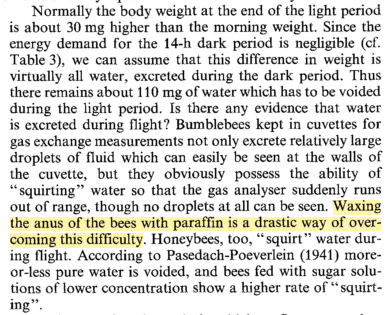All Draw Curiosity videos are fully subtitled in English and Spanish. The blog post builds on the concepts touched upon in the video
A friend of mine sent me the following picture the other day, which brought me back to a time in 2014 when I captured a bumblebee squirting on camera. They do it incredibly frequently, but this was a unique moment where I caught the entire process.
Insect physiology is fascinating in weird and wonderful ways as their bodies are entirely different to our own. For instance, rather than a circulatory system consisting of arteries, veins and capillaries like ours, their blood, the haemolymph, floats free in their bodies, and is pumped around using a chain pump heart. Likewise, they lack lungs per se, and instead have spiracles, holes which cover the surface of their bodies and through which air passes and diffuses straight into the tissues. This way of breathing actually places a functional size limit on insects – an insect may be no larger then 3cm in all three dimensions, which is why most insects are small, few insects are fat, and those which are unusually large in one dimension are probably going to be very thin in the rest (think stick insects).
Although spiracles were thought to be a passive system, many insects do have a degree of muscular control over them, and can control when they open and close them. They close them to avoid water loss, as desiccation is a problem when you are very small – much like the stomata in leaves. However, in the case of bumblebees, who require their entire body weight in nectar to fuel their flight, their diet contains a bit too much water than they need, which they must void by excreting it in a jet.
Bertsch in 1984 published “Foraging in male bumblebees (Bombus lucorum L.): maximizing energy or minimizing water load?”, which did a great job of tackling the subject of how they metabolise water, and how the limits of how much water they can intake before experiencing flooding can affect their behaviour depending on whether they are social (the female workers and queen), or solitary (the male drones).
This is specifically interesting because it goes against traditional Optimal Foraging Theory, where animals are assumed to maximise the energy they consume. Especially when you are small and fly, it is a priority to meet the energy budget every day, otherwise it may be possible you may not make it through the night. However, this research serves to show that models can occasionally be too simplistic, and more often than not behaviours are the result of various trade-offs – and in this case, it is water content ingested vs. energy derived from it for high-powered flight.
Interestingly, Bertsch’s team hadn’t witnessed the bees’ squirting in action, as it is a very quick process, but they had witnessed the aftermath (if you’ve ever kept a hive of bumblebees, you’ll be well acquainted with their sticky squirts). Here is probably my favourite passage from Bertsch’s paper:

And on that bombshell – I’ll see you in the next one! Which has a 50% chance of being on a related topic. I promise that it is coincidence.
I hope you enjoyed and learned something new today! Let me know what you think in the comments – I would love to know! If you enjoyed this blog and would like to be notified of new entries, consider signing up to the mailing list here and subscribing to the YouTube channel!
